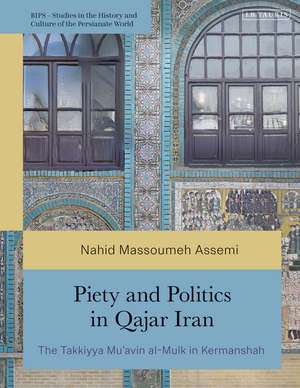Piety and Politics in Qajar Iran: The Takkiyya Mu’avin al-Mulk in Kermanshah: British Institute of Persian Studies
Autor Nahid Massoumeh Assemien Limba Engleză Hardback – 17 apr 2024
Preț: 538.77 lei
Preț vechi: 773.07 lei
-30% Nou
Puncte Express: 808
Preț estimativ în valută:
103.12€ • 106.27$ • 87.06£
103.12€ • 106.27$ • 87.06£
Carte disponibilă
Livrare economică 10-24 februarie
Preluare comenzi: 021 569.72.76
Specificații
ISBN-13: 9780755652648
ISBN-10: 0755652649
Pagini: 304
Ilustrații: 77 bw illus 22 colour illus
Dimensiuni: 189 x 246 x 23 mm
Greutate: 0.45 kg
Editura: Bloomsbury Publishing
Colecția I.B.Tauris
Seria British Institute of Persian Studies
Locul publicării:London, United Kingdom
ISBN-10: 0755652649
Pagini: 304
Ilustrații: 77 bw illus 22 colour illus
Dimensiuni: 189 x 246 x 23 mm
Greutate: 0.45 kg
Editura: Bloomsbury Publishing
Colecția I.B.Tauris
Seria British Institute of Persian Studies
Locul publicării:London, United Kingdom
Caracteristici
Examines the role of a private takkiya space in the context of nation-building and identity.
Notă biografică
Nahid Massoumeh Assemi is an independent scholar who specializes in the art and architectural history of Qajar Iran. She has published articles in the peer-review journal Iran. She is a Bahari Visiting Fellow at the Bodleian Libraries, 2023-24 and a member of the Contemporary Art Council of the Iran Heritage Foundation. She holds a PhD from the Courtauld Institute of Art, London and an MA in Fine Arts from Ecole des Beaux Arts in Paris where she was trained as a classical artist. She is also a miniaturist, illuminator and calligrapher working on commission.
Cuprins
IntroductionChapter One: Historical Background Chapter Two: The Mu'ini Family and Their Religious Establishments Chapter Three: The Forecourt Chapter Four: The Husayniyya Chapter Five: The ZaynabiyyaChapter Six: The 'Abbasiyya AppendicesAppendix One: The Poem on the Frame of the Panel of Rauza Khwani Appendix Two: The Vaqfnama Appendix Three: Muhtasham Kashani's Davazda Band on Husayn's MartyrdomAppendix Four: Ziyarat-i WarithAppendix Five: Mi 'raj of Hazrat-i Rasul and 'Ali Rescues Salman from the LionAppendix Six: Ghadir KhumAppendix Seven: The Panj Tan Appendix Eight: The Court of Ma'mun and the Naming of Imam Riza as His Successor and the Picture of Shah Riza, the Hunter and the Happy DeerAppendix Nine:Moses Throwing His Staff in the Palace of Pharaoh Glossary Bibliography
Recenzii
This is a remarkable book, which I highly recommend. Its focus is the Takkiyya Mu'avin al-Mulk and its rich decorative programmes. The author paints around these a colourful, and highly informative, picture of Iranian Shi'ism, its rites and its ceremonies. In addition, she brings to life the Takkiya's wealthy merchant patron within the setting of early 20th century Iranian society and the country's constitutional movement.







